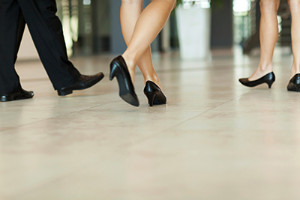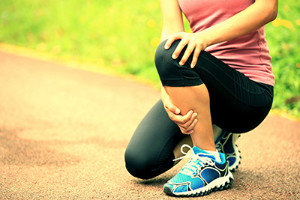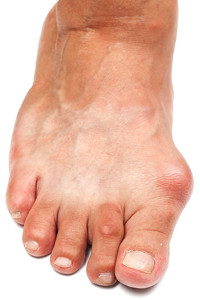Items filtered by date: September 2017
How to Take Care of Your Feet if You Work While Standing
 For those who stand most of the day while working, foot pain is common. However, there are things you can do to alleviate pain. The type of shoes you wear have a big impact on their wearability. Shoes should have enough space so that toes can move freely. Shoes like open-back heels and sandals are not very supportive and can be bad for feet. Women should also avoid high heels. Shoes should also support the arch, and if not, podiatrists offer custom-made orthotics. Athletic shoes generally offer more support and are a good choice. Stretching your feet can help deal with pain, as can soaking them in a tub. Wearing clean, dry socks can prevent athlete’s foot; foot powder can as well, while also keeping them dry. While you may have to stand all day while you work, this doesn’t mean you have to experience discomfort.
For those who stand most of the day while working, foot pain is common. However, there are things you can do to alleviate pain. The type of shoes you wear have a big impact on their wearability. Shoes should have enough space so that toes can move freely. Shoes like open-back heels and sandals are not very supportive and can be bad for feet. Women should also avoid high heels. Shoes should also support the arch, and if not, podiatrists offer custom-made orthotics. Athletic shoes generally offer more support and are a good choice. Stretching your feet can help deal with pain, as can soaking them in a tub. Wearing clean, dry socks can prevent athlete’s foot; foot powder can as well, while also keeping them dry. While you may have to stand all day while you work, this doesn’t mean you have to experience discomfort.
While working on the feet, it is important to take the proper care of them. For more information about working on your feet, contact one of our podiatrists from Sayville Foot Care. Our doctors will treat your foot and ankle needs.
Working on Your Feet
Standing on your feet for long periods of time can cause stress and pain in your feet. Your whole body may experience change in terms of posture, back pain, bunions, callouses and or plantar warts. There are ways to avoid these conditions with proper foot care, smart choices and correct posture.
Positive Changes
Negative heeled shoe – Choosing this shoe type places the heel slightly lower than the ball of the foot. These are great for overall foot health. Find shoes that fit you correctly.
Go barefoot – Our feet were not designed to be enclosed for all hours of the day. Try to periodically expose your feet to air.
Eliminate Pain
Foot Exercises – Performing simple exercises, incorporating yoga and doing stretches are beneficial. This will allow increased blood flow to the area and muscles of the foot.
Achilles tendon – Stretching the foot out flat on the floor will relax the calf muscles and tendon. These exercises can be performed almost anywhere. Make sure you add these exercises to your daily regimen.
With a little bit of this information and knowing more about foot health, you will notice changes. Foot stretches and proper footwear will help with pain and prevent further issues.
If you have any questions please feel free to contact our office located in Sayville, NY . We offer the newest diagnostic and treatment technologies for all your foot and ankle needs.
Avoiding Running Injuries
 Avoiding injuries when running is important and can make your running experience more enjoyable. For new runners, start slowly and avoid pushing yourself too hard; the key is to gradually build yourself up. Before and after a run, stretch to loosen muscles and prevent strain. Strength training can also build muscle and durability; just be sure to rest one day before running or training again. A sign that you may be pushing yourself too much is if you cannot talk in complete sentences when running; if so, you may want to slow down. Keeping a good diet to replace lost calories and vitamins, hydrating plenty, and getting enough sleep will keep your body from quickly getting fatigued. If you do feel pain, stop running. If the pain resides in your feet, take it easy and rest. If the pain doesn’t go away, you may want to see a podiatrist for a diagnosis.
Avoiding injuries when running is important and can make your running experience more enjoyable. For new runners, start slowly and avoid pushing yourself too hard; the key is to gradually build yourself up. Before and after a run, stretch to loosen muscles and prevent strain. Strength training can also build muscle and durability; just be sure to rest one day before running or training again. A sign that you may be pushing yourself too much is if you cannot talk in complete sentences when running; if so, you may want to slow down. Keeping a good diet to replace lost calories and vitamins, hydrating plenty, and getting enough sleep will keep your body from quickly getting fatigued. If you do feel pain, stop running. If the pain resides in your feet, take it easy and rest. If the pain doesn’t go away, you may want to see a podiatrist for a diagnosis.
Exercising your feet regularly with the proper foot wear is a great way to prevent injuries. If you have any concerns about your feet, contact one of our podiatrists of Sayville Foot Care. Our doctors will treat your foot and ankle needs.
How to Prevent Running Injuries
Many common running injuries are caused by overuse and overtraining. When the back of the kneecap starts wearing out and starts causing pain in your knee, this is commonly referred to as runner’s knee. Runner’s knee is a decrease in strength in your quadriceps and can occur if you’re not wearing properly fitted or supporting shoes. To prevent runner’s knee, focusing on hip strengthening is a good idea, as well as strengthening your quads to keep the kneecaps aligned.
What Are Some Causes of Running Injuries?
- One cause of a common running injury is called iliotibial band syndrome.
- Plantar fasciitis is also another common injury.
- Stress fractures can occur from overtraining, lack of calcium, or even your running style.
Best Ways to Prevent Running Injuries
- Wear footwear that fits properly and suits your running needs.
- Running shoes are the only protective gear that runners have to safeguard them from injury.
- Make a training schedule. Adding strengthening exercises as well as regular stretching can help keep you strong and limber and can lessen the possibility of injuries.
- Stretching keeps muscles limber; this will help you gain better flexibility.
If you have any questions please feel free to contact our office located in Sayville, NY . We offer the newest diagnostic and treatment technologies for all your foot and ankle needs.
Phillies CF Florimon Injuries Ankle
 Philadelphia Phillies center fielder, Pedro Florimon, recently dislocated his right ankle during a game against the Miami Marlins. Florimon had to be taken off the field on a cart. The injury was severe enough to unfortunately end the rest of the season for him. This was Florimon’s first year with the Phillies, and he had been playing well with a batting average of .348. The Phillies already have two outfielders disabled, and the loss of Florimon will temporarily strain them.
Philadelphia Phillies center fielder, Pedro Florimon, recently dislocated his right ankle during a game against the Miami Marlins. Florimon had to be taken off the field on a cart. The injury was severe enough to unfortunately end the rest of the season for him. This was Florimon’s first year with the Phillies, and he had been playing well with a batting average of .348. The Phillies already have two outfielders disabled, and the loss of Florimon will temporarily strain them.
Sports related foot and ankle injuries require proper treatment before players can go back to their regular routines. For more information, contact one of our podiatrists of Sayville Foot Care. Our doctors can provide the care you need to keep you pain-free and on your feet.
Sports Related Foot and Ankle Injuries
Foot and ankle injuries are a common occurrence when it comes to athletes of any sport. While many athletes dismiss the initial aches and pains, the truth is that ignoring potential foot and ankle injuries can lead to serious problems. As athletes continue to place pressure and strain the area further, a mild injury can turn into something as serious as a rupture and may lead to a permanent disability. There are many factors that contribute to sports related foot and ankle injuries, which include failure to warm up properly, not providing support or wearing bad footwear. Common injuries and conditions athletes face, including:
- Plantar Fasciitis
- Plantar Fasciosis
- Achilles Tendinitis
- Achilles Tendon Rupture
- Ankle Sprains
Sports related injuries are commonly treated using the RICE method. This includes rest, applying ice to the injured area, compression and elevating the ankle. More serious sprains and injuries may require surgery, which could include arthroscopic and reconstructive surgery. Rehabilitation and therapy may also be required in order to get any recovering athlete to become fully functional again. Any unusual aches and pains an athlete sustains must be evaluated by a licensed, reputable medical professional.
If you have any questions please feel free to contact our office located in Sayville, NY . We offer the newest diagnostic and treatment technologies for all your foot and ankle needs.
What are Bunions?
 Hallux valgus, better known as bunions, is an enlargement of the inner portion of the joint at the base of the big toe. This can cause pain, tenderness, and redness near the big toe. Movement can worsen the pain, and overtime, the misalignment can become worse. Several conditions have been linked to bunions, with genetics playing a role as well. These include flat feet, obesity, abnormal bone structures, and overly flexible ligaments. Those of European descent are more likely to suffer from bunions. Shoes that aren’t wide enough and high heels can exacerbate bunions. While not all bunions require surgery, it is important to see a podiatrist first who can observe the severity of the deformation and provide treatment.
Hallux valgus, better known as bunions, is an enlargement of the inner portion of the joint at the base of the big toe. This can cause pain, tenderness, and redness near the big toe. Movement can worsen the pain, and overtime, the misalignment can become worse. Several conditions have been linked to bunions, with genetics playing a role as well. These include flat feet, obesity, abnormal bone structures, and overly flexible ligaments. Those of European descent are more likely to suffer from bunions. Shoes that aren’t wide enough and high heels can exacerbate bunions. While not all bunions require surgery, it is important to see a podiatrist first who can observe the severity of the deformation and provide treatment.
If you are suffering from bunions, contact one of our podiatrists of Sayville Foot Care. Our doctors can provide the care you need to keep you pain-free and on your feet.
What Is a Bunion?
A bunion is formed of swollen tissue or an enlargement of boney growth, usually located at the base joint of the toe that connects to the foot. The swelling occurs due to the bones in the big toe shifting inward, which impacts the other toes of the foot. This causes the area around the base of the big toe to become inflamed and painful.
Why Do Bunions Form?
Genetics – Susceptibility to bunions are often hereditary
Stress on the feet – Poorly fitted and uncomfortable footwear that places stress on feet, such as heels, can worsen existing bunions
How Are Bunions Diagnosed?
Doctors often perform two tests – blood tests and x-rays – when trying to diagnose bunions, especially in the early stages of development. Blood tests help determine if the foot pain is being caused by something else, such as arthritis, while x-rays provide a clear picture of your bone structure to your doctor.
How Are Bunions Treated?
- Refrain from wearing heels or similar shoes that cause discomfort
- Select wider shoes that can provide more comfort and reduce pain
- Anti-inflammatory and pain management drugs
- Orthotics or foot inserts
- Surgery
If you have any questions, please feel free to contact our office located in Sayville, NY . We offer the newest diagnostic and treatment technologies for all your foot care needs.
